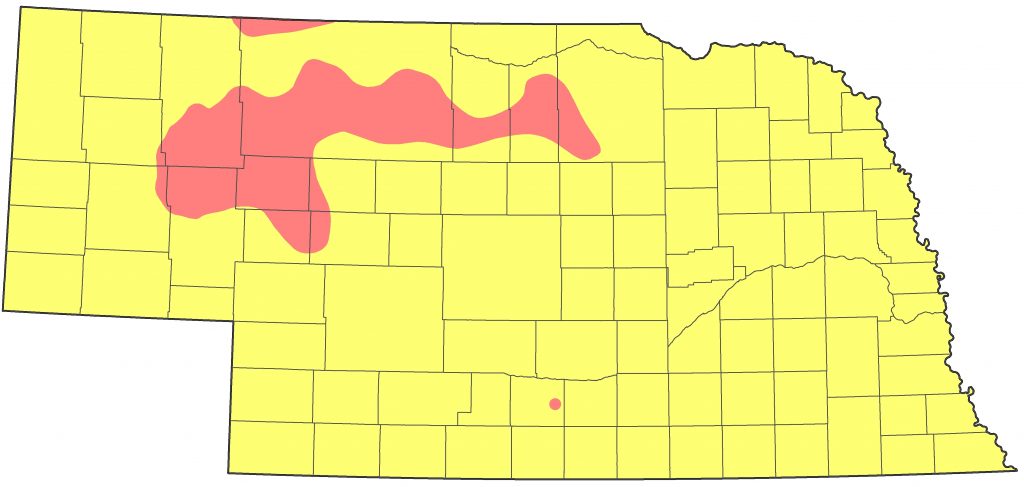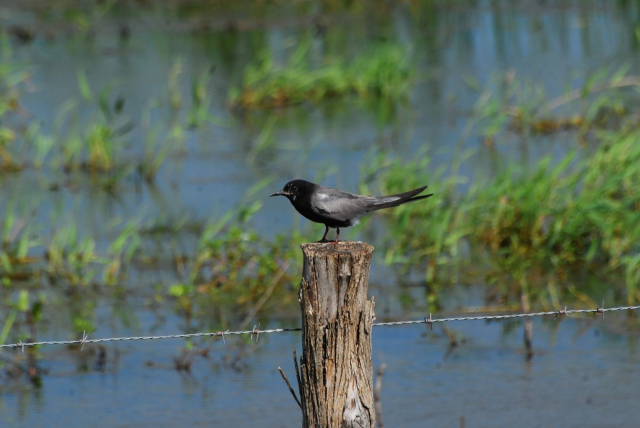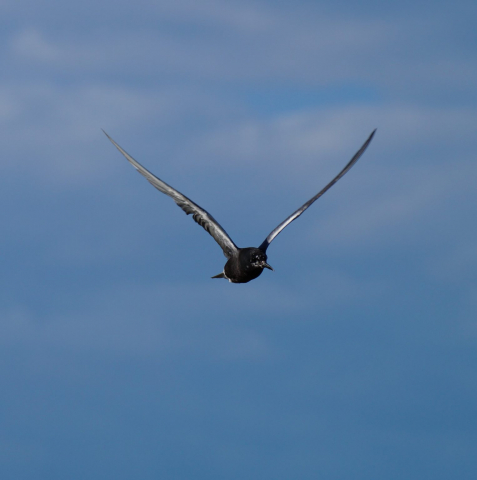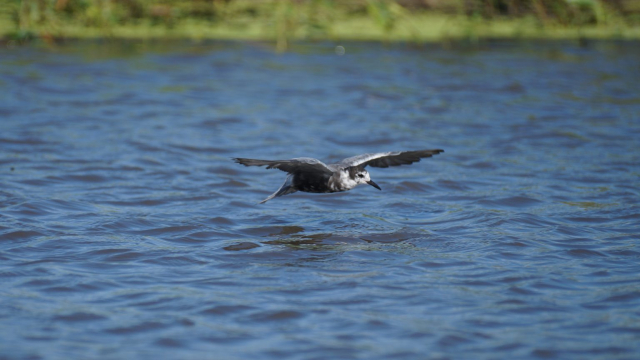Chlidonias niger surinamensis
Status: Common regular spring and fall migrant statewide. Common regular breeder north and west, accidental Rainwater Basin. Uncommon summer visitor away from breeding areas. Documentation: Specimen: UNSM ZM12725, 21 May 1895 Lancaster Co.
Documentation: Specimen: UNSM ZM12725, 21 May 1895 Lancaster Co.
Taxonomy: Two subspecies are recognized: niger of central Asia, and surinamensis of Canada and North America (AviList 2025).
Nebraska birds are surinamensis.
Spring: Apr 26, 26, 27 <<<>>> summer
An early date was 15 Apr 2025 Valentine NWR, Cherry Co.
Individuals usually arrive in early May, peak migration occurs in late May, and migrants are still moving through in numbers well into Jun. As many as 100 were observed at Funk WPA, Phelps Co as late as 11 Jun 1996.
- High counts: 2100 in the eastern Rainwater Basin 26-28 May 2001 (400 at Harvard WPA, Clay Co 27 May), 1569 at Lake McConaughy, Keith Co 5 Jun 2005, and 1500 at Lake Ogallala, Keith Co 26 May 2003.
Summer: This species formerly bred throughout the state (Bruner et al 1904, Mollhoff 2022), but degradation of suitable habitat has left the species restricted to the marshes of the Sandhills. However, it continues to experience sharp declines. BBS trend analysis shows an annual decline in Nebraska of -5.74 (95% C.I.; -9.79, -1.66) during the period 1966-2015 (Sauer et al 2017); for the period 1966-2019 (Sauer et al 2020) the corresponding figures were -3.757 (95% C.I., -9.23, 1.895) suggesting a slight improvement. Szczys (2006) found 53 nests at Crescent Lake NWR, Garden Co in 2006 and hatching success was only 22% with as many as 44% depredated by bullsnakes (Pituophis catenifer).
There are several older records of breeding in the Rainwater Basin (Mollhoff 2022), but none after about 1920 (Jorgensen 2012) until the first modern record in 2007, a flightless young bird found at Funk WPA 17 Jul (Mollhoff 2008).
There are numerous mid-summer (late Jun-early Jul) reports south of the Platte River; most such birds are one-year-old immatures and non-breeding adults. Few one-year-olds migrate as far as the breeding range; they constitute only 1-3% of the birds in the breeding range (Heath et al 2020).
- Breeding Phenology:
Eggs: 28 May-29 Jun - Nestlings: 4 Jul
- A “fresh immature” was at Lake McConaughy, Keith Co 21 Jun 2022, likely locally hatched.
Fall: summer <<<>>> Oct 1, 2, 3
There are later dates of two on 13 Oct 2013 at Pawnee Lake, Lancaster Co, 14 Oct 2013 Branched Oak Lake, Lancaster Co, and 18 Oct (year not given) Keith Co Area (Brown and Brown 2001).
Returning birds appear as early as the end of Jun, many of which are probably failed breeders. The first juveniles appear in mid-Jul, although both adults and juveniles were at Funk WPA 3 Jul 2007. Peak migration occurs in late Jul and Aug, with very few passing through after mid-Sep.
- High counts: 625 at Lake Ogallala 12 Aug 2024, 450 in the eastern Rainwater Basin 16 Jul 2000, 428 at Lake McConaughy 20 Aug 1998, and 403 there 29 Jul 2006.
Images
Abbreviations
BBS: Breeding Bird Survey
NWR: National Wildlife Refuge
UNSM: University of Nebraska State Museum
WPA: Waterfowl Production Area (Federal)
Literature Cited
AviList Core Team, 2025. AviList: The Global Avian Checklist, v2025. https://doi.org/10.2173/avilist.v2025.
Brown, C.R., and M.B. Brown. 2001. Birds of the Cedar Point Biological Station. Occasional Papers of the Cedar Point Biological Station, No. 1.
Bruner, L., R.H. Wolcott, and M.H. Swenk. 1904. A preliminary review of the birds of Nebraska, with synopses. Klopp and Bartlett, Omaha, Nebraska, USA.
Heath, S.R., E.H. Dunn, and D.J. Agro. 2020. Black Tern (Chlidonias niger), version 1.0. In Birds of the World (S. M. Billerman, Editor). Cornell Lab of Ornithology, Ithaca, NY, USA. https://doi.org/10.2173/bow.blkter.01.
Jorgensen, J.G. 2012. Birds of the Rainwater Basin, Nebraska. Nebraska Game and Parks Commission, Lincoln, Nebraska, USA.
Mollhoff, W.J. 2008. The 2007 Nebraska nest report. NBR 76: 155-165.
Mollhoff, W.J. 2022. Nest records of Nebraska birds. Nebraska Ornithologists’ Union Occasional Paper Number 9.
Sauer, J.R., W.A. Link, and J.E. Hines. 2020. The North American Breeding Bird Survey, Analysis Results 1966 – 2019: U.S. Geological Survey data release, https://doi.org/10.5066/P96A7675.
Sauer, J.R., D.K. Niven, J.E. Hines, D.J. Ziolkowski, Jr, K.L. Pardieck, J.E. Fallon, and W.A. Link. 2017. The North American Breeding Bird Survey, Results and Analysis 1966 – 2015 (Nebraska). Version 2.07. USGS Patuxent Wildlife Research Center, Laurel, Maryland, USA.
Szczys, P. 2006. Investigation of the breeding biology and population genetic structure of the Black Tern, Chlidonias niger. A final report submitted to: Nebraska Game and Parks Commission, Nebraska Bird Partnership and Playa Lakes Joint Venture and retrieved from the Nebraska Game and Parks Commission, Lincoln, Nebraska, USA.
Recommended Citation
Silcock, W.R., and J.G. Jorgensen. 2025. Black Tern (Chlidonias niger surinamensis). In Birds of Nebraska — Online. www.BirdsofNebraska.org
Birds of Nebraska – Online
Updated 2 Sep 2025



